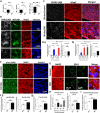Self-Organizing 3D Human Neural Tissue Derived from Induced Pluripotent Stem Cells Recapitulate Alzheimer's Disease Phenotypes
- PMID: 27622770
- PMCID: PMC5021368
- DOI: 10.1371/journal.pone.0161969
Self-Organizing 3D Human Neural Tissue Derived from Induced Pluripotent Stem Cells Recapitulate Alzheimer's Disease Phenotypes
Abstract
The dismal success rate of clinical trials for Alzheimer's disease (AD) motivates us to develop model systems of AD pathology that have higher predictive validity. The advent of induced pluripotent stem cells (iPSCs) allows us to model pathology and study disease mechanisms directly in human neural cells from healthy individual as well as AD patients. However, two-dimensional culture systems do not recapitulate the complexity of neural tissue, and phenotypes such as extracellular protein aggregation are difficult to observe. We report brain organoids that use pluripotent stem cells derived from AD patients and recapitulate AD-like pathologies such as amyloid aggregation, hyperphosphorylated tau protein, and endosome abnormalities. These pathologies are observed in an age-dependent manner in organoids derived from multiple familial AD (fAD) patients harboring amyloid precursor protein (APP) duplication or presenilin1 (PSEN1) mutation, compared to controls. The incidence of AD pathology was consistent amongst several fAD lines, which carried different mutations. Although these are complex assemblies of neural tissue, they are also highly amenable to experimental manipulation. We find that treatment of patient-derived organoids with β- and γ-secretase inhibitors significantly reduces amyloid and tau pathology. Moreover, these results show the potential of this model system to greatly increase the translatability of pre-clinical drug discovery in AD.
Conflict of interest statement
The authors have declared that no competing interests exist.
Figures



Similar articles
-
Neurons derived from sporadic Alzheimer's disease iPSCs reveal elevated TAU hyperphosphorylation, increased amyloid levels, and GSK3B activation.Alzheimers Res Ther. 2017 Dec 1;9(1):90. doi: 10.1186/s13195-017-0317-z. Alzheimers Res Ther. 2017. PMID: 29191219 Free PMC article.
-
Modeling amyloid beta and tau pathology in human cerebral organoids.Mol Psychiatry. 2018 Dec;23(12):2363-2374. doi: 10.1038/s41380-018-0229-8. Epub 2018 Aug 31. Mol Psychiatry. 2018. PMID: 30171212 Free PMC article.
-
A Large Panel of Isogenic APP and PSEN1 Mutant Human iPSC Neurons Reveals Shared Endosomal Abnormalities Mediated by APP β-CTFs, Not Aβ.Neuron. 2019 Oct 23;104(2):256-270.e5. doi: 10.1016/j.neuron.2019.07.010. Epub 2019 Aug 12. Neuron. 2019. PMID: 31416668
-
The Breakthroughs and Caveats of Using Human Pluripotent Stem Cells in Modeling Alzheimer's Disease.Cells. 2023 Jan 27;12(3):420. doi: 10.3390/cells12030420. Cells. 2023. PMID: 36766763 Free PMC article. Review.
-
Human Pluripotent Stem Cell-Derived Neural Cells as a Relevant Platform for Drug Screening in Alzheimer's Disease.Int J Mol Sci. 2020 Sep 18;21(18):6867. doi: 10.3390/ijms21186867. Int J Mol Sci. 2020. PMID: 32962164 Free PMC article. Review.
Cited by
-
Modeling Neurological Disorders in 3D Organoids Using Human-Derived Pluripotent Stem Cells.Front Cell Dev Biol. 2021 May 10;9:640212. doi: 10.3389/fcell.2021.640212. eCollection 2021. Front Cell Dev Biol. 2021. PMID: 34041235 Free PMC article. Review.
-
A Three-Dimensional Alzheimer's Disease Cell Culture Model Using iPSC-Derived Neurons Carrying A246E Mutation in PSEN1.Front Cell Neurosci. 2020 Jun 12;14:151. doi: 10.3389/fncel.2020.00151. eCollection 2020. Front Cell Neurosci. 2020. PMID: 32655369 Free PMC article.
-
Functional genomics and the future of iPSCs in disease modeling.Stem Cell Reports. 2022 May 10;17(5):1033-1047. doi: 10.1016/j.stemcr.2022.03.019. Epub 2022 Apr 28. Stem Cell Reports. 2022. PMID: 35487213 Free PMC article. Review.
-
Modelling mitochondrial dysfunction in Alzheimer's disease using human induced pluripotent stem cells.World J Stem Cells. 2019 May 26;11(5):236-253. doi: 10.4252/wjsc.v11.i5.236. World J Stem Cells. 2019. PMID: 31171953 Free PMC article. Review.
-
Organs to Cells and Cells to Organoids: The Evolution of in vitro Central Nervous System Modelling.Front Cell Neurosci. 2019 Apr 9;13:129. doi: 10.3389/fncel.2019.00129. eCollection 2019. Front Cell Neurosci. 2019. PMID: 31024259 Free PMC article. Review.
References
-
- Alzheimer A. Über eigenartige Krankheitsfalle des späteren Alters. Zbl ges Neurol Psych. 1911; 4 356–385.
MeSH terms
Substances
Grants and funding
LinkOut - more resources
Full Text Sources
Other Literature Sources
Medical
Research Materials

